The main goal of initial treatment is to control the bleeding, prevent any complication relating to it, and eliminate the underlying cause whenever possible, and to identify patients at risk for rebleeding or those who will need admission to the hospital for further treatment.
Initial resuscitation and supportive care
Patients who are actively bleeding and/or with multiple medical comorbidities should be attended to as an emergency. Initial management includes assessment of hemodynamic stability and resuscitation if necessary, implementing the ABC (airway, breathing, and circulation) approach.[58]Cappell MS, Friedel D. Initial management of acute upper gastrointestinal bleeding: from initial evaluation up to gastrointestinal endoscopy. Med Clin North Am. 2008 May;92(3):491-509.
http://www.ncbi.nlm.nih.gov/pubmed/18387374?tool=bestpractice.com
Patients in shock should be managed in a critical care setting wherever possible. Diagnostic assessment is performed simultaneously.
Endotracheal intubation should be performed in patients with airway obstruction from continued hematemesis or altered respiratory or mental status. Endotracheal intubation will protect the airway and facilitate endoscopy. Bilateral, peripheral, or central intravenous access is important to facilitate both blood transfusion and fluid replacement, if required.
Blood transfusion (packed red blood cells [RBCs]) may be necessary in certain cases (ongoing bleeding, or low hemoglobin [Hb] at presentation). Guidelines differ in exact thresholds.
The American College of Gastroenterologists (ACG) recommends transfusion for hemodynamically stable patients with upper gastrointestinal (GI) bleeding when Hb <7 g/dL.[39]Laine L, Barkun AN, Saltzman JR, et al. ACG clinical guideline: upper gastrointestinal and ulcer bleeding. Am J Gastroenterol. 2021 May 1;116(5):899-917.
https://journals.lww.com/ajg/fulltext/2021/05000/acg_clinical_guideline__upper_gastrointestinal_and.14.aspx
http://www.ncbi.nlm.nih.gov/pubmed/33929377?tool=bestpractice.com
Hypotensive patients may receive transfusion at a higher threshold, and in patients with preexisting cardiovascular disease, transfusion is reasonable when Hb <8 g/dL. Patients with acute coronary syndrome may be considered for transfusion when Hb >8 g/dL, but the guidelines note that this is based on very limited evidence.[39]Laine L, Barkun AN, Saltzman JR, et al. ACG clinical guideline: upper gastrointestinal and ulcer bleeding. Am J Gastroenterol. 2021 May 1;116(5):899-917.
https://journals.lww.com/ajg/fulltext/2021/05000/acg_clinical_guideline__upper_gastrointestinal_and.14.aspx
http://www.ncbi.nlm.nih.gov/pubmed/33929377?tool=bestpractice.com
The International Consensus Group suggests transfusion for patients with acute upper GI bleeding without cardiovascular disease when Hb is <8 g/dL, with a higher threshold for those with cardiovascular disease.[40]Barkun AN, Almadi M, Kuipers EJ, et al. Management of nonvariceal upper gastrointestinal bleeding: guideline recommendations from the International Consensus Group. Ann Intern Med. 2019 Dec 3;171(11):805-22.
https://www.acpjournals.org/doi/full/10.7326/M19-1795
http://www.ncbi.nlm.nih.gov/pubmed/31634917?tool=bestpractice.com
Similarly, although it does not specify ranges, the American College of Chest Physicians recommends a restrictive transfusion strategy over a permissive transfusion strategy in critically ill patients, notably including those with acute GI bleeding, but in critically ill patients with acute coronary syndrome it suggests against a restrictive transfusion strategy.[41]Coz Yataco AO, Soghier I, Hébert PC, et al. Red blood cell transfusion in critically ill adults: an American College of Chest Physicians clinical practice guideline. Chest. 2025 Feb;167(2):477-89.
https://pmc.ncbi.nlm.nih.gov/articles/PMC11867898
http://www.ncbi.nlm.nih.gov/pubmed/39341492?tool=bestpractice.com
A post-transfusion target of Hb ≥10 g/dL should be aimed for in patients with cardiovascular disease (CVD), while a lower level of Hb 7-9 g/dL is considered appropriate for patients without CVD.[1]Alali AA, Barkun AN. An update on the management of non-variceal upper gastrointestinal bleeding. Gastroenterol Rep (Oxf). 2023 Mar 20;11:goad011.
https://academic.oup.com/gastro/article/doi/10.1093/gastro/goad011/7081277
http://www.ncbi.nlm.nih.gov/pubmed/36949934?tool=bestpractice.com
Electrolyte abnormalities should be corrected.
Platelets and coagulation factors should be given in certain circumstances. Patients on antiplatelet treatment should not receive platelet transfusions.[59]Abraham NS, Barkun AN, Sauer BG, et al. American College of Gastroenterology-Canadian Association of Gastroenterology clinical practice guideline: management of anticoagulants and antiplatelets during acute gastrointestinal bleeding and the periendoscopic period. Am J Gastroenterol. 2022 Apr 1;117(4):542-58.
https://www.doi.org/10.14309/ajg.0000000000001627
http://www.ncbi.nlm.nih.gov/pubmed/35297395?tool=bestpractice.com
The ACG recommend against the use of fresh frozen plasma or vitamin K in patients with acute GI bleeding who are on warfarin.[59]Abraham NS, Barkun AN, Sauer BG, et al. American College of Gastroenterology-Canadian Association of Gastroenterology clinical practice guideline: management of anticoagulants and antiplatelets during acute gastrointestinal bleeding and the periendoscopic period. Am J Gastroenterol. 2022 Apr 1;117(4):542-58.
https://www.doi.org/10.14309/ajg.0000000000001627
http://www.ncbi.nlm.nih.gov/pubmed/35297395?tool=bestpractice.com
Prothrombin complex concentrate can be considered in patients on warfarin with a life-threatening GI bleed or those with a supratherapeutic INR substantially exceeding the therapeutic range. Prothrombin complex concentrate can also be considered for patients in whom massive blood transfusion is undesirable because of its effect on coagulopathy or dilution of blood components.[59]Abraham NS, Barkun AN, Sauer BG, et al. American College of Gastroenterology-Canadian Association of Gastroenterology clinical practice guideline: management of anticoagulants and antiplatelets during acute gastrointestinal bleeding and the periendoscopic period. Am J Gastroenterol. 2022 Apr 1;117(4):542-58.
https://www.doi.org/10.14309/ajg.0000000000001627
http://www.ncbi.nlm.nih.gov/pubmed/35297395?tool=bestpractice.com
Patients on direct oral anticoagulants (DOACs) should not routinely be given prothrombin complex concentrate; those on dabigatran should not routinely receive idarucizumab, and those on rivaroxaban or apixaban should not routinely receive recombinant coagulation factor Xa (andexanet alfa). These recommendations are based on limited evidence of benefit. However, reversal of anticoagulation with these agents may be considered in hospitalized patients with a life-threatening GI bleed who have taken a DOAC within the past 24 hours.[59]Abraham NS, Barkun AN, Sauer BG, et al. American College of Gastroenterology-Canadian Association of Gastroenterology clinical practice guideline: management of anticoagulants and antiplatelets during acute gastrointestinal bleeding and the periendoscopic period. Am J Gastroenterol. 2022 Apr 1;117(4):542-58.
https://www.doi.org/10.14309/ajg.0000000000001627
http://www.ncbi.nlm.nih.gov/pubmed/35297395?tool=bestpractice.com
Patients on aspirin for secondary prevention should continue with this; if aspirin is stopped, it should be restarted on the day hemostasis is confirmed endoscopically.[59]Abraham NS, Barkun AN, Sauer BG, et al. American College of Gastroenterology-Canadian Association of Gastroenterology clinical practice guideline: management of anticoagulants and antiplatelets during acute gastrointestinal bleeding and the periendoscopic period. Am J Gastroenterol. 2022 Apr 1;117(4):542-58.
https://www.doi.org/10.14309/ajg.0000000000001627
http://www.ncbi.nlm.nih.gov/pubmed/35297395?tool=bestpractice.com
Several risk scoring systems have been developed and validated, but each has been shown to perform most accurately to predict particular outcomes: for example, mortality, risk of rebleeding, need for transfusion, or the need for surgical or endoscopic therapy. In summary, the major international, American, and European upper GI bleeding guidelines only suggest the Glasgow-Blatchford bleeding score (GBS) to identify, with high certainty, very low-risk patients who can be safely managed with outpatient endoscopy.[39]Laine L, Barkun AN, Saltzman JR, et al. ACG clinical guideline: upper gastrointestinal and ulcer bleeding. Am J Gastroenterol. 2021 May 1;116(5):899-917.
https://journals.lww.com/ajg/fulltext/2021/05000/acg_clinical_guideline__upper_gastrointestinal_and.14.aspx
http://www.ncbi.nlm.nih.gov/pubmed/33929377?tool=bestpractice.com
[40]Barkun AN, Almadi M, Kuipers EJ, et al. Management of nonvariceal upper gastrointestinal bleeding: guideline recommendations from the International Consensus Group. Ann Intern Med. 2019 Dec 3;171(11):805-22.
https://www.acpjournals.org/doi/full/10.7326/M19-1795
http://www.ncbi.nlm.nih.gov/pubmed/31634917?tool=bestpractice.com
[42]Gralnek IM, Stanley AJ, Morris AJ, et al. Endoscopic diagnosis and management of nonvariceal upper gastrointestinal hemorrhage (NVUGIH): European Society of Gastrointestinal Endoscopy (ESGE) guideline - update 2021. Endoscopy. 2021 Mar;53(3):300-32.
https://www.esge.com/endoscopic-diagnosis-and-management-of-nonvariceal-upper-gastrointestinal-hemorrhage-esge-update-2021
http://www.ncbi.nlm.nih.gov/pubmed/33567467?tool=bestpractice.com
The GBS (pre-endoscopy score) is calculated using the following parameters: blood urea nitrogen, Hb, systolic blood pressure, pulse, melena, syncope, liver disease, and cardiac failure.[38]Stanley AJ, Ashley D, Dalton HR, et al. Outpatient management of patients with low-risk upper-gastrointestinal haemorrhage: multicentre validation and prospective evaluation. Lancet. 2009 Jan 3;373(9657):42-7.
http://www.ncbi.nlm.nih.gov/pubmed/19091393?tool=bestpractice.com
[43]Masaoka T, Suzuki H, Hori S, et al. Blatchford scoring system is a useful scoring system for detecting patients with upper gastrointestinal bleeding who do not need endoscopic intervention. J Gastroenterol Hepatol. 2007 Sep;22(9):1404-8.
http://www.ncbi.nlm.nih.gov/pubmed/17716345?tool=bestpractice.com
[44]Srirajaskanthan R, Conn R, Bulwer C, et al. The Glasgow Blatchford scoring system enables accurate risk stratification of patients with upper gastrointestinal haemorrhage. Int J Clin Pract. 2010 Jun;64(7):868-74.
http://www.ncbi.nlm.nih.gov/pubmed/20337750?tool=bestpractice.com
Patients with a score of 0-1 are classified as very low-risk, which indicates a ≤1% false negative rate for requiring in-hospital interventions or death.[39]Laine L, Barkun AN, Saltzman JR, et al. ACG clinical guideline: upper gastrointestinal and ulcer bleeding. Am J Gastroenterol. 2021 May 1;116(5):899-917.
https://journals.lww.com/ajg/fulltext/2021/05000/acg_clinical_guideline__upper_gastrointestinal_and.14.aspx
http://www.ncbi.nlm.nih.gov/pubmed/33929377?tool=bestpractice.com
[40]Barkun AN, Almadi M, Kuipers EJ, et al. Management of nonvariceal upper gastrointestinal bleeding: guideline recommendations from the International Consensus Group. Ann Intern Med. 2019 Dec 3;171(11):805-22.
https://www.acpjournals.org/doi/full/10.7326/M19-1795
http://www.ncbi.nlm.nih.gov/pubmed/31634917?tool=bestpractice.com
[42]Gralnek IM, Stanley AJ, Morris AJ, et al. Endoscopic diagnosis and management of nonvariceal upper gastrointestinal hemorrhage (NVUGIH): European Society of Gastrointestinal Endoscopy (ESGE) guideline - update 2021. Endoscopy. 2021 Mar;53(3):300-32.
https://www.esge.com/endoscopic-diagnosis-and-management-of-nonvariceal-upper-gastrointestinal-hemorrhage-esge-update-2021
http://www.ncbi.nlm.nih.gov/pubmed/33567467?tool=bestpractice.com
Patients with a score of ≥2 should be admitted promptly and receive an endoscopy within 24 hours.[1]Alali AA, Barkun AN. An update on the management of non-variceal upper gastrointestinal bleeding. Gastroenterol Rep (Oxf). 2023 Mar 20;11:goad011.
https://academic.oup.com/gastro/article/doi/10.1093/gastro/goad011/7081277
http://www.ncbi.nlm.nih.gov/pubmed/36949934?tool=bestpractice.com
[39]Laine L, Barkun AN, Saltzman JR, et al. ACG clinical guideline: upper gastrointestinal and ulcer bleeding. Am J Gastroenterol. 2021 May 1;116(5):899-917.
https://journals.lww.com/ajg/fulltext/2021/05000/acg_clinical_guideline__upper_gastrointestinal_and.14.aspx
http://www.ncbi.nlm.nih.gov/pubmed/33929377?tool=bestpractice.com
[
Blatchford score for gastrointestinal bleeding
Opens in new window
]
Pharmacologic treatment
Initial pharmacologic management may include an antiemetic, erythromycin, and a proton-pump inhibitor (PPI).
Erythromycin
Erythromycin is thought to stimulate motilin receptors, with subsequent increase in stomach contraction, which may help to mobilize gastric clots and allow better esophagogastroduodenoscopy (EGD) assessment.[39]Laine L, Barkun AN, Saltzman JR, et al. ACG clinical guideline: upper gastrointestinal and ulcer bleeding. Am J Gastroenterol. 2021 May 1;116(5):899-917.
https://journals.lww.com/ajg/fulltext/2021/05000/acg_clinical_guideline__upper_gastrointestinal_and.14.aspx
http://www.ncbi.nlm.nih.gov/pubmed/33929377?tool=bestpractice.com
[50]Winstead NS, Wilcox CM. Erythromycin prior to endoscopy for acute upper gastrointestinal haemorrhage: a cost-effectiveness analysis. Aliment Pharmacol Ther. 2007 Nov 15;26(10):1371-7.
http://www.ncbi.nlm.nih.gov/pubmed/17848180?tool=bestpractice.com
[51]Das A. Should erythromycin be administered before endoscopy for acute upper gastrointestinal hemorrhage? Nat Clin Pract Gastroenterol Hepatol. 2008 Jul;5(7):358-9.
http://www.ncbi.nlm.nih.gov/pubmed/18521113?tool=bestpractice.com
[52]Coffin B, Pocard M, Panis Y, et al. Erythromycin improves the quality of EGD in patients with acute upper GI bleeding: a randomized controlled study. Gastrointest Endosc. 2002 Aug;56(2):174-9.
http://www.ncbi.nlm.nih.gov/pubmed/12145593?tool=bestpractice.com
[53]Carbonell N, Pauwels A, Serfaty L, et al. Erythromycin infusion prior to endoscopy for acute upper gastrointestinal bleeding: a randomized, controlled, double-blind trial. Am J Gastroenterol. 2006 Jun;101(6):1211-5.
https://journals.lww.com/ajg/fulltext/2006/06000/erythromycin_infusion_prior_to_endoscopy_for_acute.10.aspx
http://www.ncbi.nlm.nih.gov/pubmed/16771939?tool=bestpractice.com
In one systematic review conducted by the American College of Gastroenterologists, erythromycin reduced the number of repeat endoscopies, and the length of hospitalizations by at least 1 day.[39]Laine L, Barkun AN, Saltzman JR, et al. ACG clinical guideline: upper gastrointestinal and ulcer bleeding. Am J Gastroenterol. 2021 May 1;116(5):899-917.
https://journals.lww.com/ajg/fulltext/2021/05000/acg_clinical_guideline__upper_gastrointestinal_and.14.aspx
http://www.ncbi.nlm.nih.gov/pubmed/33929377?tool=bestpractice.com
Promotility agents should not be used routinely before endoscopy to increase the diagnostic yield.[1]Alali AA, Barkun AN. An update on the management of non-variceal upper gastrointestinal bleeding. Gastroenterol Rep (Oxf). 2023 Mar 20;11:goad011.
https://academic.oup.com/gastro/article/doi/10.1093/gastro/goad011/7081277
http://www.ncbi.nlm.nih.gov/pubmed/36949934?tool=bestpractice.com
[40]Barkun AN, Almadi M, Kuipers EJ, et al. Management of nonvariceal upper gastrointestinal bleeding: guideline recommendations from the International Consensus Group. Ann Intern Med. 2019 Dec 3;171(11):805-22.
https://www.acpjournals.org/doi/full/10.7326/M19-1795
http://www.ncbi.nlm.nih.gov/pubmed/31634917?tool=bestpractice.com
They may be considered if there is suspected large volume food or blood in the stomach.[60]Barkun AN, Bardou M, Kuipers EJ, et al. International consensus recommendations on the management of patients with nonvariceal upper gastrointestinal bleeding. Ann Intern Med. 2010 Jan 19;152(2):101-13.
https://www.acpjournals.org/doi/10.7326/0003-4819-152-2-201001190-00009
http://www.ncbi.nlm.nih.gov/pubmed/20083829?tool=bestpractice.com
There are few data to support the use of metoclopramide.[39]Laine L, Barkun AN, Saltzman JR, et al. ACG clinical guideline: upper gastrointestinal and ulcer bleeding. Am J Gastroenterol. 2021 May 1;116(5):899-917.
https://journals.lww.com/ajg/fulltext/2021/05000/acg_clinical_guideline__upper_gastrointestinal_and.14.aspx
http://www.ncbi.nlm.nih.gov/pubmed/33929377?tool=bestpractice.com
Antisecretory therapy
The role of PPIs in Mallory-Weiss tear (MWT) is not clear. Guidelines have made conflicting recommendations regarding the administration of PPIs prior to diagnostic EGD, when the exact cause of the bleeding remains unclear.[39]Laine L, Barkun AN, Saltzman JR, et al. ACG clinical guideline: upper gastrointestinal and ulcer bleeding. Am J Gastroenterol. 2021 May 1;116(5):899-917.
https://journals.lww.com/ajg/fulltext/2021/05000/acg_clinical_guideline__upper_gastrointestinal_and.14.aspx
http://www.ncbi.nlm.nih.gov/pubmed/33929377?tool=bestpractice.com
[40]Barkun AN, Almadi M, Kuipers EJ, et al. Management of nonvariceal upper gastrointestinal bleeding: guideline recommendations from the International Consensus Group. Ann Intern Med. 2019 Dec 3;171(11):805-22.
https://www.acpjournals.org/doi/full/10.7326/M19-1795
http://www.ncbi.nlm.nih.gov/pubmed/31634917?tool=bestpractice.com
[  ]
For people with upper gastrointestinal bleeding, what are the effects of proton pump inhibitors (PPIs) prior to endoscopic diagnosis?/cca.html?targetUrl=https://www.cochranelibrary.com/cca/doi/10.1002/cca.3988/fullShow me the answer
]
For people with upper gastrointestinal bleeding, what are the effects of proton pump inhibitors (PPIs) prior to endoscopic diagnosis?/cca.html?targetUrl=https://www.cochranelibrary.com/cca/doi/10.1002/cca.3988/fullShow me the answer
Given the lack of certainty around the data, it is suggested that local protocols are followed. Some experts still suggest pre-endoscopy PPIs to downgrade any high-risk lesions particularly when early endoscopy cannot be performed, or if contraindications to endoscopic evaluation exist.[49]Mullady DK, Wang AY, Waschke KA. AGA clinical practice update on endoscopic therapies for non-variceal upper gastrointestinal bleeding: expert review. Gastroenterology. 2020 Sep;159(3):1120-8.
https://www.gastrojournal.org/article/S0016-5085(20)34848-4/fulltext
http://www.ncbi.nlm.nih.gov/pubmed/32574620?tool=bestpractice.com
In the experience of this author, the benefits of giving PPIs prior to endoscopy outweigh potential harms and PPIs are widely administered for nonvariceal upper GI bleeding.
PPI treatment started before endoscopy may reduce the need for endoscopic treatment in patients with nonvariceal bleeding.[61]Kanno T, Yuan Y, Tse F, et al. Proton pump inhibitor treatment initiated prior to endoscopic diagnosis in upper gastrointestinal bleeding. Cochrane Database Syst Rev. 2022 Jan 7;1(1):CD005415.
https://www.cochranelibrary.com/cdsr/doi/10.1002/14651858.CD005415.pub4/full
http://www.ncbi.nlm.nih.gov/pubmed/34995368?tool=bestpractice.com
[  ]
For people with upper gastrointestinal bleeding, what are the effects of proton pump inhibitors (PPIs) prior to endoscopic diagnosis?/cca.html?targetUrl=https://www.cochranelibrary.com/cca/doi/10.1002/cca.3988/fullShow me the answer However, the benefit of using a PPI to prevent rebleeding, and reduce mortality or need for surgery, has not been demonstrated in patients with nonvariceal bleeding.[61]Kanno T, Yuan Y, Tse F, et al. Proton pump inhibitor treatment initiated prior to endoscopic diagnosis in upper gastrointestinal bleeding. Cochrane Database Syst Rev. 2022 Jan 7;1(1):CD005415.
https://www.cochranelibrary.com/cdsr/doi/10.1002/14651858.CD005415.pub4/full
http://www.ncbi.nlm.nih.gov/pubmed/34995368?tool=bestpractice.com
[62]Tajima A, Koizumi K, Suzuki K, et al. Proton pump inhibitors and recurrent bleeding in peptic ulcer disease. J Gastroenterol Hepatol. 2008 Dec:23 Suppl 2:S237-41.
http://www.ncbi.nlm.nih.gov/pubmed/19120905?tool=bestpractice.com
[63]Khuroo MS, Khuroo MS, Farahat KL, et al. Treatment with proton pump inhibitors in acute non-variceal upper gastrointestinal bleeding: a meta-analysis. J Gastroenterol Hepatol. 2005 Jan;20(1):11-25.
http://www.ncbi.nlm.nih.gov/pubmed/15610441?tool=bestpractice.com
[
]
For people with upper gastrointestinal bleeding, what are the effects of proton pump inhibitors (PPIs) prior to endoscopic diagnosis?/cca.html?targetUrl=https://www.cochranelibrary.com/cca/doi/10.1002/cca.3988/fullShow me the answer However, the benefit of using a PPI to prevent rebleeding, and reduce mortality or need for surgery, has not been demonstrated in patients with nonvariceal bleeding.[61]Kanno T, Yuan Y, Tse F, et al. Proton pump inhibitor treatment initiated prior to endoscopic diagnosis in upper gastrointestinal bleeding. Cochrane Database Syst Rev. 2022 Jan 7;1(1):CD005415.
https://www.cochranelibrary.com/cdsr/doi/10.1002/14651858.CD005415.pub4/full
http://www.ncbi.nlm.nih.gov/pubmed/34995368?tool=bestpractice.com
[62]Tajima A, Koizumi K, Suzuki K, et al. Proton pump inhibitors and recurrent bleeding in peptic ulcer disease. J Gastroenterol Hepatol. 2008 Dec:23 Suppl 2:S237-41.
http://www.ncbi.nlm.nih.gov/pubmed/19120905?tool=bestpractice.com
[63]Khuroo MS, Khuroo MS, Farahat KL, et al. Treatment with proton pump inhibitors in acute non-variceal upper gastrointestinal bleeding: a meta-analysis. J Gastroenterol Hepatol. 2005 Jan;20(1):11-25.
http://www.ncbi.nlm.nih.gov/pubmed/15610441?tool=bestpractice.com
[  ]
For people with upper gastrointestinal bleeding, what are the effects of proton pump inhibitors (PPIs) prior to endoscopic diagnosis?/cca.html?targetUrl=https://www.cochranelibrary.com/cca/doi/10.1002/cca.3988/fullShow me the answer In patients with bleeding ulcers, intravenous bolus followed by continuous infusion has been shown to effectively decrease rebleeding in patients who have had successful endoscopic therapy, but these data are difficult to interpret in light of MWT.[64]Laine L, McQuaid KR. Endoscopic therapy for bleeding ulcers: an evidence-based approach based on meta-analyses of randomized controlled trials. Clin Gastroenterol Hepatol. 2009 Jan;7(1):33-47; quiz 1-2.
https://www.doi.org/10.1016/j.cgh.2008.08.016
http://www.ncbi.nlm.nih.gov/pubmed/18986845?tool=bestpractice.com
]
For people with upper gastrointestinal bleeding, what are the effects of proton pump inhibitors (PPIs) prior to endoscopic diagnosis?/cca.html?targetUrl=https://www.cochranelibrary.com/cca/doi/10.1002/cca.3988/fullShow me the answer In patients with bleeding ulcers, intravenous bolus followed by continuous infusion has been shown to effectively decrease rebleeding in patients who have had successful endoscopic therapy, but these data are difficult to interpret in light of MWT.[64]Laine L, McQuaid KR. Endoscopic therapy for bleeding ulcers: an evidence-based approach based on meta-analyses of randomized controlled trials. Clin Gastroenterol Hepatol. 2009 Jan;7(1):33-47; quiz 1-2.
https://www.doi.org/10.1016/j.cgh.2008.08.016
http://www.ncbi.nlm.nih.gov/pubmed/18986845?tool=bestpractice.com
If given pre-endoscopy, PPIs are generally administered via the intravenous route. Common PPIs used for actively bleeding lesions include intravenous pantoprazole or esomeprazole. Oral PPI therapy should be considered in those not actively bleeding.[62]Tajima A, Koizumi K, Suzuki K, et al. Proton pump inhibitors and recurrent bleeding in peptic ulcer disease. J Gastroenterol Hepatol. 2008 Dec:23 Suppl 2:S237-41.
http://www.ncbi.nlm.nih.gov/pubmed/19120905?tool=bestpractice.com
[63]Khuroo MS, Khuroo MS, Farahat KL, et al. Treatment with proton pump inhibitors in acute non-variceal upper gastrointestinal bleeding: a meta-analysis. J Gastroenterol Hepatol. 2005 Jan;20(1):11-25.
http://www.ncbi.nlm.nih.gov/pubmed/15610441?tool=bestpractice.com
Oral esomeprazole or rabeprazole can be used.
H2 antagonists can be considered as an alternative therapy to PPIs when PPIs are contraindicated. However, treatment with PPIs achieves more profound and sustained acid suppression than H2 antagonists.[65]Uedo N, Takeuchi Y, Yamada T, et al. Effect of a proton pump inhibitor or an H2-receptor antagonist on prevention of bleeding from ulcer after endoscopic submucosal dissection of early gastric cancer: a prospective randomized controlled trial. Am J Gastroenterol. 2007 Aug;102(8):1610-6.
https://journals.lww.com/ajg/fulltext/2007/08000/effect_of_a_proton_pump_inhibitor_or_an.7.aspx
http://www.ncbi.nlm.nih.gov/pubmed/17403076?tool=bestpractice.com
[66]Gostishchev VK, Evseev MA. Antisecretory therapy as a component of hemostasis in acute gastroduodenal ulcer bleeding [in Russian]. Khirurgiia (Mosk). 2005:(8):52-7.
http://www.ncbi.nlm.nih.gov/pubmed/16091681?tool=bestpractice.com
For actively bleeding lesions, intravenous famotidine can be given followed by oral famotidine. For non-actively bleeding lesions, oral famotidine or cimetidine can be given.
Antiemetics
An antiemetic is useful for controlling nausea and vomiting, which may be a cause or an aggravating factor in patients with MWT, and is administered pre-endoscopy, if needed.
Common antiemetics recommended include promethazine, ondansetron, prochlorperazine, and trimethobenzamide.
Endoscopic treatment
EGD is the procedure of choice for patients with nonvariceal upper GI bleeding.[49]Mullady DK, Wang AY, Waschke KA. AGA clinical practice update on endoscopic therapies for non-variceal upper gastrointestinal bleeding: expert review. Gastroenterology. 2020 Sep;159(3):1120-8.
https://www.gastrojournal.org/article/S0016-5085(20)34848-4/fulltext
http://www.ncbi.nlm.nih.gov/pubmed/32574620?tool=bestpractice.com
[56]Hastings PR, Peters KW, Cohn I Jr. Mallory-Weiss syndrome: review of 69 cases. Am J Surg. 1981 Nov;142(5):560-2.
http://www.ncbi.nlm.nih.gov/pubmed/7304810?tool=bestpractice.com
It is usually performed after resuscitation, stabilization, and pharmacologic treatment is given. It should be performed within 24 hours of upper GI bleeding presentation.[39]Laine L, Barkun AN, Saltzman JR, et al. ACG clinical guideline: upper gastrointestinal and ulcer bleeding. Am J Gastroenterol. 2021 May 1;116(5):899-917.
https://journals.lww.com/ajg/fulltext/2021/05000/acg_clinical_guideline__upper_gastrointestinal_and.14.aspx
http://www.ncbi.nlm.nih.gov/pubmed/33929377?tool=bestpractice.com
The International Consensus Group makes a conditional recommendation based on very low-quality evidence that in patients receiving anticoagulants, endoscopy should not be delayed. The degree of coagulopathy, anticoagulant agent, and patient physiology should be assessed before making therapeutic decisions, and coagulopathy should be treated as necessary, but given the recognized benefits of early endoscopy, it proposes that endoscopy should not be delayed.[40]Barkun AN, Almadi M, Kuipers EJ, et al. Management of nonvariceal upper gastrointestinal bleeding: guideline recommendations from the International Consensus Group. Ann Intern Med. 2019 Dec 3;171(11):805-22.
https://www.acpjournals.org/doi/full/10.7326/M19-1795
http://www.ncbi.nlm.nih.gov/pubmed/31634917?tool=bestpractice.com
Several endoscopic modalities are effective for treating high-risk bleeding lesions such as an oozing or an actively bleeding/spurting tear. The choice of methods used will depend on the endoscopist's familiarity, experience, and training, and on equipment availability.
Studies have not demonstrated clear superiority of one technique over others.[67]Freeman ML. New and old methods for endoscopic control of nonvariceal upper gastrointestinal bleedings. Rev Gastroenterol Mex. 2003 Nov:68 Suppl 3:62-5.
http://www.ncbi.nlm.nih.gov/pubmed/15146801?tool=bestpractice.com
[68]Saltzman JR, Strate LL, Di Sena V, et al. Prospective trial of endoscopic clips versus combination therapy in upper GI bleeding (PROTECCT - upper GI bleeding). Am J Gastroenterol. 2005 Jul;100(7):1503-8.
https://journals.lww.com/ajg/fulltext/2005/07000/prospective_trial_of_endoscopic_clips_versus.14.aspx
http://www.ncbi.nlm.nih.gov/pubmed/15984972?tool=bestpractice.com
[69]Park CH, Min SW, Sohn YH, et al. A prospective, randomized trial of endoscopic band ligation vs. epinephrine injection for actively bleeding Mallory-Weiss syndrome. Gastrointest Endosc. 2004 Jul;60(1):22-7.
http://www.ncbi.nlm.nih.gov/pubmed/15229420?tool=bestpractice.com
However, dual therapy is superior to single therapy such as epinephrine (adrenaline) injection. Complete endoscopic exam is recommended because coexisting lesions are commonly associated with MWT.
Different modalities of treatment include the following:
Injection therapy is commonly used in the treatment of ulceration causing upper GI bleeding, in combination with thermal or mechanical therapy. Its role in the management of MWT bleeding has been studied in a small series.[70]Peng YC, Tung CF, Chow WK, et al. Efficacy of endoscopic isotonic saline-epinephrine injection for the management of active Mallory-Weiss tears. J Clin Gastroenterol. 2001 Feb;32(2):119-22.
http://www.ncbi.nlm.nih.gov/pubmed/11205645?tool=bestpractice.com
[71]Chau CH, Siu WT, Law BK, et al. Randomized controlled trial comparing epinephrine injection plus heat probe coagulation versus epinephrine injection plus argon plasma coagulation for bleeding peptic ulcers. Gastrointest Endosc. 2003 Apr;57(4):455-61.
http://www.ncbi.nlm.nih.gov/pubmed/12665753?tool=bestpractice.com
Epinephrine injection is generally the most common agent used: this agent stops or reduces the bleeding rate by vasoconstriction and tamponade. It is injected around or into the bleeding point. Sclerosant agents, such as ethanolamine and alcohol, have been described in the literature; however, they are rarely used in practice.[72]Bataller R, Llach J, Salmeron JM, et al. Endoscopic sclerotherapy in upper gastrointestinal bleeding due to the Mallory-Weiss syndrome. Am J Gastroenterol. 1994 Dec;89(12):2147-50.
http://www.ncbi.nlm.nih.gov/pubmed/7977231?tool=bestpractice.com
[Figure caption and citation for the preceding image starts]: Actively bleeding tear appears as a red longitudinal defect with normal surrounding mucosaFrom the collection of Juan Carlos Munoz, MD, University of Florida [Citation ends].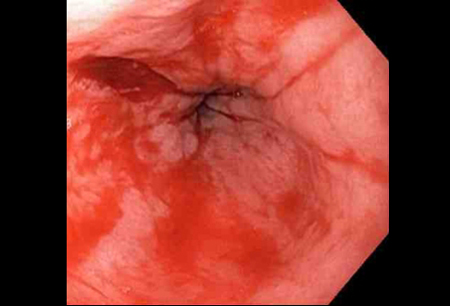 [Figure caption and citation for the preceding image starts]: Epinephrine (adrenaline) is injected locally around the site of the Mallory-Weiss tearFrom the collection of Juan Carlos Munoz, MD, University of Florida [Citation ends].
[Figure caption and citation for the preceding image starts]: Epinephrine (adrenaline) is injected locally around the site of the Mallory-Weiss tearFrom the collection of Juan Carlos Munoz, MD, University of Florida [Citation ends].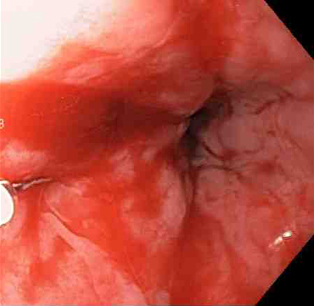 [Figure caption and citation for the preceding image starts]: Mallory-Weiss tear after epinephrine injection (the bleeding has stopped, allowing better visualization of the lesion)From the collection of Juan Carlos Munoz, MD, University of Florida [Citation ends].
[Figure caption and citation for the preceding image starts]: Mallory-Weiss tear after epinephrine injection (the bleeding has stopped, allowing better visualization of the lesion)From the collection of Juan Carlos Munoz, MD, University of Florida [Citation ends].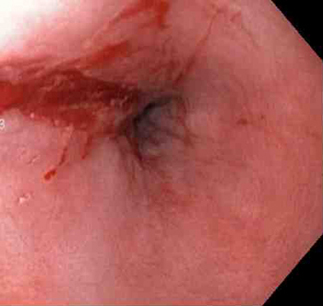
Through-the-scope clips (TTSCs), alone or in combination with epinephrine injection, can effectively control actively bleeding lesions, and the clips are as effective and safe as other methods.[73]Yuan Y, Wang C, Hunt RH. Endoscopic clipping for acute nonvariceal upper-GI bleeding: a meta-analysis and critical appraisal of randomized controlled trials. Gastrointest Endosc. 2008 Aug;68(2):339-51.
http://www.ncbi.nlm.nih.gov/pubmed/18656600?tool=bestpractice.com
[74]Sung JJ, Tsoi KK, Lai LH, et al. Endoscopic clipping versus injection and thermo-coagulation in the treatment of non-variceal upper gastrointestinal bleeding: a meta-analysis. Gut. 2007 Oct;56(10):1364-73.
https://pmc.ncbi.nlm.nih.gov/articles/PMC2000277
http://www.ncbi.nlm.nih.gov/pubmed/17566018?tool=bestpractice.com
[75]Guo SB, Gong AX, Leng J, et al. Application of endoscopic hemoclips for nonvariceal bleeding in the upper gastrointestinal tract. Worl J Gastroentererol. 2009 Sep 14;15(34):4322-6.
https://pmc.ncbi.nlm.nih.gov/articles/PMC2744190
http://www.ncbi.nlm.nih.gov/pubmed/19750577?tool=bestpractice.com
In the author's experience, this is the technique of choice in a patient with an actively bleeding tear or laceration. The application of TTSCs and an endoloop in the esophagus has also been described as a method of closure of large MWTs.[76]Ivekovic H, Rustemovic N, Brkic T, et al. The esophagus as a working channel: successful closure of a large Mallory-Weiss tear with clips and an endoloop. Endoscopy. 2011:43 Suppl 2:E170.
https://www.thieme-connect.com/products/ejournals/pdf/10.1055/s-0030-1256273.pdf
http://www.ncbi.nlm.nih.gov/pubmed/21563067?tool=bestpractice.com
[Figure caption and citation for the preceding image starts]: A through-the-scope clip deployed in the center of the lesion (no previous epinephrine was infused in this case)From the collection of Juan Carlos Munoz, MD, University of Florida [Citation ends].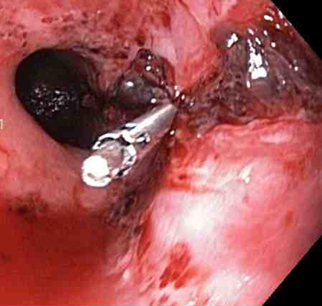 [Figure caption and citation for the preceding image starts]: Nonbleeding adherent clotFrom the collection of Juan Carlos Munoz, MD, University of Florida [Citation ends].
[Figure caption and citation for the preceding image starts]: Nonbleeding adherent clotFrom the collection of Juan Carlos Munoz, MD, University of Florida [Citation ends].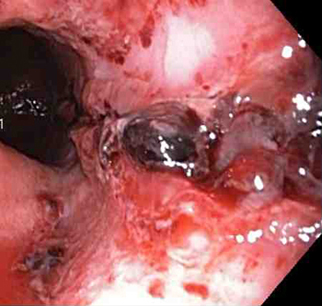 [Figure caption and citation for the preceding image starts]: Three through-the-scope clips deployed to complete closure of the mucosal defectFrom the collection of Juan Carlos Munoz, MD, University of Florida [Citation ends].
[Figure caption and citation for the preceding image starts]: Three through-the-scope clips deployed to complete closure of the mucosal defectFrom the collection of Juan Carlos Munoz, MD, University of Florida [Citation ends].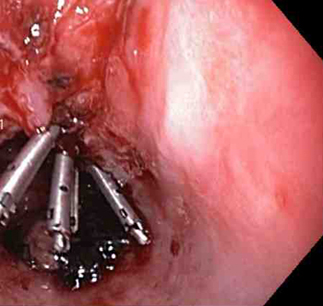
Over-the-scope clips (OTSC) are available from several vendors and are larger, often permanent clips that have been shown to be effective in treating a wide variety of nonvariceal upper GI bleeding sources, including MWT.[77]Skinner M, Gutierrez JP, Neumann H, et al. Over-the-scope clip placement is effective rescue therapy for severe acute upper gastrointestinal bleeding. Endosc Int Open. 2014 Mar;2(1):E37-40.
https://pmc.ncbi.nlm.nih.gov/articles/PMC4423243
http://www.ncbi.nlm.nih.gov/pubmed/26134611?tool=bestpractice.com
[78]He K, Pang K, Ying L, et al. Meta-analysis: over-the-scope clips in patients at high risk of re-bleeding following upper gastrointestinal tract bleeding. Aliment Pharmacol Ther. 2024 Jul;60(2):112-23.
http://www.ncbi.nlm.nih.gov/pubmed/38818831?tool=bestpractice.com
[79]Mangiafico S, Pigò F, Bertani H, et al. Over-the-scope clip vs epinephrine with clip for first-line hemostasis in non-variceal upper gastrointestinal bleeding: a propensity score match analysis. Endosc Int Open. 2020 Jan;8(1):E50-8.
https://pmc.ncbi.nlm.nih.gov/articles/PMC6949178
http://www.ncbi.nlm.nih.gov/pubmed/31921984?tool=bestpractice.com
Various topical hemostatic agents that promote hemostasis have been shown to be a promising rescue therapy, or adjunct to conventional methods for treating upper GI bleeding including MWT.[1]Alali AA, Barkun AN. An update on the management of non-variceal upper gastrointestinal bleeding. Gastroenterol Rep (Oxf). 2023 Mar 20;11:goad011.
https://academic.oup.com/gastro/article/doi/10.1093/gastro/goad011/7081277
http://www.ncbi.nlm.nih.gov/pubmed/36949934?tool=bestpractice.com
[40]Barkun AN, Almadi M, Kuipers EJ, et al. Management of nonvariceal upper gastrointestinal bleeding: guideline recommendations from the International Consensus Group. Ann Intern Med. 2019 Dec 3;171(11):805-22.
https://www.acpjournals.org/doi/full/10.7326/M19-1795
http://www.ncbi.nlm.nih.gov/pubmed/31634917?tool=bestpractice.com
[80]Sinha R, Lockman KA, Church NI, et al. The use of hemostatic spray as an adjunct to conventional hemostatic measures in high-risk nonvariceal upper GI bleeding. Gastrointest Endosc. 2016 Dec;84(6):900-6.
https://www.giejournal.org/article/S0016-5107(16)30062-1/fulltext
http://www.ncbi.nlm.nih.gov/pubmed/27108061?tool=bestpractice.com
[81]Changela K, Papafragkakis H, Ofori E, et al. Hemostatic powder spray: a new method for managing gastrointestinal bleeding. Therap Adv Gastroenterol. 2015 May;8(3):125-35.
https://pmc.ncbi.nlm.nih.gov/articles/PMC4454021
http://www.ncbi.nlm.nih.gov/pubmed/26082803?tool=bestpractice.com
[82]Haddara S, Jacques J, Lecleire S, et al. A novel hemostatic powder for upper gastrointestinal bleeding: a multicenter study (the "GRAPHE" registry). Endoscopy. 2016 Dec;48(12):1084-95.
http://www.ncbi.nlm.nih.gov/pubmed/27760437?tool=bestpractice.com
They can be administered through the upper endoscope during EGD.[83]Giles H, Lal D, Gerred S, et al. Efficacy and safety of TC-325 (HemosprayTM) for non-variceal upper gastrointestinal bleeding at Middlemore Hospital: the early New Zealand experience. N Z Med J. 2016 Dec 2;129(1446):38-43.
http://www.ncbi.nlm.nih.gov/pubmed/27906917?tool=bestpractice.com
[84]Branchi F, Klingenberg-Noftz R, Friedrich K, et al. PuraStat in gastrointestinal bleeding: results of a prospective multicentre observational pilot study. Surg Endosc. 2022 May;36(5):2954-61.
https://pmc.ncbi.nlm.nih.gov/articles/PMC9001238
http://www.ncbi.nlm.nih.gov/pubmed/34129089?tool=bestpractice.com
[85]de Nucci G, Reati R, Arena I, et al. Efficacy of a novel self-assembling peptide hemostatic gel as rescue therapy for refractory acute gastrointestinal bleeding. Endoscopy. 2020 Sep;52(9):773-9.
http://www.ncbi.nlm.nih.gov/pubmed/32316041?tool=bestpractice.com
Thermocoagulation therapy (also known as thermal therapy) includes multipolar electrocoagulation (MPEC), heater probe, and argon plasma coagulation (APC). It may be used as a single therapy; however, it is most commonly used in combination with injection therapy. Thermal therapies including MPEC or heater probe are reserved for actively bleeding lesions. They are often successful and safely given by experienced operators; however, contact thermal therapy should be used with caution when used in the esophagus for a bleeding MWT because of the risk of perforation.[1]Alali AA, Barkun AN. An update on the management of non-variceal upper gastrointestinal bleeding. Gastroenterol Rep (Oxf). 2023 Mar 20;11:goad011.
https://academic.oup.com/gastro/article/doi/10.1093/gastro/goad011/7081277
http://www.ncbi.nlm.nih.gov/pubmed/36949934?tool=bestpractice.com
[86]Laine L. Multipolar electrocoagulation in the treatment of active upper gastrointestinal tract hemorrhage. A prospective controlled trial. N Engl J Med. 1987 Jun 25;316(26):1613-7.
http://www.ncbi.nlm.nih.gov/pubmed/3295547?tool=bestpractice.com
[87]Papp JP. Electrocoagulation of actively bleeding Mallory-Weiss tears. Gastrointest Endosc. 1980 Nov;26(4):128-30.
http://www.ncbi.nlm.nih.gov/pubmed/7450460?tool=bestpractice.com
The evidence for APC in this scenario is limited. However, the lack of contact between the catheter and the tissue results in a superficial hemostasis, reducing unwanted tissue damage and perforation, making this technique attractive in certain cases in which other methods of treatment are not available.[88]Kim HS. Endoscopic management of Mallory-Weiss tearing. Clin Endosc. 2015 Mar;48(2):102-5.
https://pmc.ncbi.nlm.nih.gov/articles/PMC4381135
http://www.ncbi.nlm.nih.gov/pubmed/25844336?tool=bestpractice.com
Endoscopic band ligation (EBL) has been described in case reports and small controlled trials, but in the experience of this author, is not commonly used for treatment of MWT. The mechanism is similar to that described for variceal band ligation: the affected mucosa is suctioned into the ligating cup device, after which a rubber band is deployed. EBL is simple and safe.[89]Matsui S, Kamisako T, Kudo M, et al. Endoscopic band ligation for control of nonvariceal upper GI hemorrhage: comparison with bipolar electrocoagulation. Gastrointest Endosc. 2002 Feb;55(2):214-8.
http://www.ncbi.nlm.nih.gov/pubmed/11818925?tool=bestpractice.com
[90]Cho YS, Chae HS, Kim HK, et al. Endoscopic band ligation and endoscopic hemoclip placement for patients with Mallory-Weiss syndrome and active bleeding. World J Gastroenterol. 2008 Apr 7;14(13):2080-4.
https://www.ncbi.nlm.nih.gov/pmc/articles/PMC2701530
http://www.ncbi.nlm.nih.gov/pubmed/18395910?tool=bestpractice.com
[91]Ertekin C, Taviloglu K, Barbaros U, et al. Endoscopic band ligation: alternative treatment method in nonvariceal upper gastrointestinal hemorrhage. J Laparoendosc Adv Surg Tech A. 2002 Feb;12(1):41-5.
http://www.ncbi.nlm.nih.gov/pubmed/11905861?tool=bestpractice.com
For most patients, EBL is used as a single therapy in which the bleeding point is aspirated and ligated. In some unusual cases, in which the bleeding point is not easily localized, EBL has been used as a combination therapy with epinephrine. Epinephrine injection may decrease or slow down the bleeding and help to localize the bleeding point.
Surgery or angiography
Surgery, which in practice is very rarely warranted in patients with MWT, should be reserved for situations where endoscopic hemostasis of bleeding has failed or transmural esophageal perforation has occurred.[56]Hastings PR, Peters KW, Cohn I Jr. Mallory-Weiss syndrome: review of 69 cases. Am J Surg. 1981 Nov;142(5):560-2.
http://www.ncbi.nlm.nih.gov/pubmed/7304810?tool=bestpractice.com
Laparoscopic over-sewing of the laceration at the gastroesophageal junction can be readily performed under video control with endoscopic guidance with excellent results.[92]Kitano S, Ueno K, Hashizume M, et al. Laparoscopic oversewing of a bleeding Mallory-Weiss tear under endoscopic guidance. Surg Endosc. 1993 Sep-Oct;7(5):445-6.
http://www.ncbi.nlm.nih.gov/pubmed/8211627?tool=bestpractice.com
Angiography is indicated for massive bleeding when EGD and surgery are not readily available, or when patients have an absolute contraindication to surgery or endoscopic therapy.[93]Blocksom JM, Tokioka S, Sugawa C. Current therapy for nonvariceal upper gastrointestinal bleeding. Surg Endosc. 2004 Feb;18(2):186-92.
http://www.ncbi.nlm.nih.gov/pubmed/14625723?tool=bestpractice.com
[94]Loffroy R, Rao P, Ota S, et al. Embolization of acute nonvariceal upper gastrointestinal hemorrhage resistant to endoscopic treatment: results and predictors of recurrent bleeding. Cardiovasc Intervent Radiol. 2010 Dec;33(6):1088-100.
http://www.ncbi.nlm.nih.gov/pubmed/20232200?tool=bestpractice.com
Angiography can involve either of the following methods:
Infusion of a vasoconstrictor agent such as vasopressin into the superior mesenteric artery or left gastric artery, or by direct infusion into a vessel that leads to a bleeding artery.[95]Thomas E, Reddy KR. Systemic vasopressin therapy for Mallory-Weiss bleeding. South Med J. 1982 Jun;75(6):691-3.
http://www.ncbi.nlm.nih.gov/pubmed/6979795?tool=bestpractice.com
Transcatheter embolization with an artificial material such as gelfoam or less often with the patient's own clotted blood.[96]Pezzulli FA, Purnell FM, Dillon EH. The Mallory-Weiss syndrome: case report and update on embolization versus intraarterial vasopressin results. N Y State J Med. 1986 Jun;86(6):312-4.
http://www.ncbi.nlm.nih.gov/pubmed/3461335?tool=bestpractice.com
[97]Clark RA, Colley DP, Eggers FM. Acute arterial gastrointestinal hemorrhage: efficacy of transcatheter control. AJR Am J Roentgenol. 1981 Jun;136(6):1185-9.
https://www.ajronline.org/doi/epdf/10.2214/ajr.136.6.1185
http://www.ncbi.nlm.nih.gov/pubmed/6786033?tool=bestpractice.com
 ]
]
 ]
However, the benefit of using a PPI to prevent rebleeding, and reduce mortality or need for surgery, has not been demonstrated in patients with nonvariceal bleeding.[61][62][63]
[
]
However, the benefit of using a PPI to prevent rebleeding, and reduce mortality or need for surgery, has not been demonstrated in patients with nonvariceal bleeding.[61][62][63]
[  ]
In patients with bleeding ulcers, intravenous bolus followed by continuous infusion has been shown to effectively decrease rebleeding in patients who have had successful endoscopic therapy, but these data are difficult to interpret in light of MWT.[64]
]
In patients with bleeding ulcers, intravenous bolus followed by continuous infusion has been shown to effectively decrease rebleeding in patients who have had successful endoscopic therapy, but these data are difficult to interpret in light of MWT.[64]  [Figure caption and citation for the preceding image starts]: Epinephrine (adrenaline) is injected locally around the site of the Mallory-Weiss tearFrom the collection of Juan Carlos Munoz, MD, University of Florida [Citation ends].
[Figure caption and citation for the preceding image starts]: Epinephrine (adrenaline) is injected locally around the site of the Mallory-Weiss tearFrom the collection of Juan Carlos Munoz, MD, University of Florida [Citation ends]. [Figure caption and citation for the preceding image starts]: Mallory-Weiss tear after epinephrine injection (the bleeding has stopped, allowing better visualization of the lesion)From the collection of Juan Carlos Munoz, MD, University of Florida [Citation ends].
[Figure caption and citation for the preceding image starts]: Mallory-Weiss tear after epinephrine injection (the bleeding has stopped, allowing better visualization of the lesion)From the collection of Juan Carlos Munoz, MD, University of Florida [Citation ends].
 [Figure caption and citation for the preceding image starts]: Nonbleeding adherent clotFrom the collection of Juan Carlos Munoz, MD, University of Florida [Citation ends].
[Figure caption and citation for the preceding image starts]: Nonbleeding adherent clotFrom the collection of Juan Carlos Munoz, MD, University of Florida [Citation ends]. [Figure caption and citation for the preceding image starts]: Three through-the-scope clips deployed to complete closure of the mucosal defectFrom the collection of Juan Carlos Munoz, MD, University of Florida [Citation ends].
[Figure caption and citation for the preceding image starts]: Three through-the-scope clips deployed to complete closure of the mucosal defectFrom the collection of Juan Carlos Munoz, MD, University of Florida [Citation ends].
